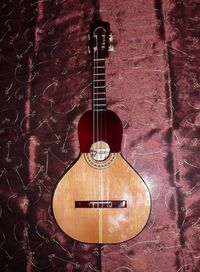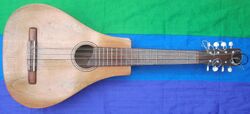Engineering:Bandola
From HandWiki
The bandola is one of many varieties of small pear-shape chordophones found in Venezuela and Colombia. They are related to the bandurria and mandolin.
Traditional varieties
Instruments known as bandola include:[1]
- Bandola llanera: traditionally with only seven frets and four nylon or gut strings. Venezuelan musicians Saúl Vera, Moisés Torrealba and Mafer Bandola have used larger 10, 14 and 16-fret versions, respectively.
- Bandola andina colombiana: this instrument has six courses of strings in several different arrangements. It may have 12 strings in doubled courses, 14 strings with the first two courses tripled and the rest doubled, 16 strings with the first four courses tripled and the last two doubled, or 18 strings in triple courses. The instrument strongly resembles its ancestor, the Spanish bandurria.[2] This instrument resembles the Mexican bandolón.
- Bandola oriental: like the bandola llanera but with a deeper body and four double courses with eight strings in all, with both nylon and metal strings.
- Bandola guayanesa: played in Venezuela's Guayana Region, with eight metal strings, paired in four courses.[3] The instrument combines techniques of the oriental and llanera bandolas.[4][5]
- Bandola Andina or Bandola Aymara or Peruvian Bandola or Bolivian Bandola: These have 4 courses of triple, or sometimes quadruple strings.
Modern varieties
- Luís Alberto Paredes Rodríguez and Manuel Bernal Martínez build a range of bandola bajo ("bass bandola"). These instruments have 12 strings in six courses and a fanned fretboard.[6]
- Some mandolin players convert their instruments to a bandola oriental by adding a fixed bridge and stringing with nylon strings.
Gallery
See also
- Venezuelan music
Notes
- ↑ Dale Olsen; Daniel Sheehy (17 December 2007). Handbook of Latin American Music, Second Edition. Routledge. pp. 300–. ISBN 978-1-135-90008-3. https://books.google.com/books?id=RK6TAgAAQBAJ&pg=PA300.
- ↑ Biblioteca de Autores y Temas Tachirenses. 1961. p. 133. https://books.google.com/books?id=zIczAQAAIAAJ.
- ↑ Aldemaro Romero (2004). El joropo llanero y el joropo central. SACVEN. p. 59. https://books.google.com/books?id=5a8UAQAAIAAJ.
- ↑ Atlas de tradiciones venezolanas. Fundación Bigott. 1998. p. 130. https://books.google.com/books?id=7AXXAAAAMAAJ.
- ↑ http://stringedinstrumentdatabase.aornis.com/
- ↑ "The Colombian Andean Bandola" by Luis Alberto Paredes Rodriguez and Manuel Bernal Martinez, American Lutherie #96, 2008











